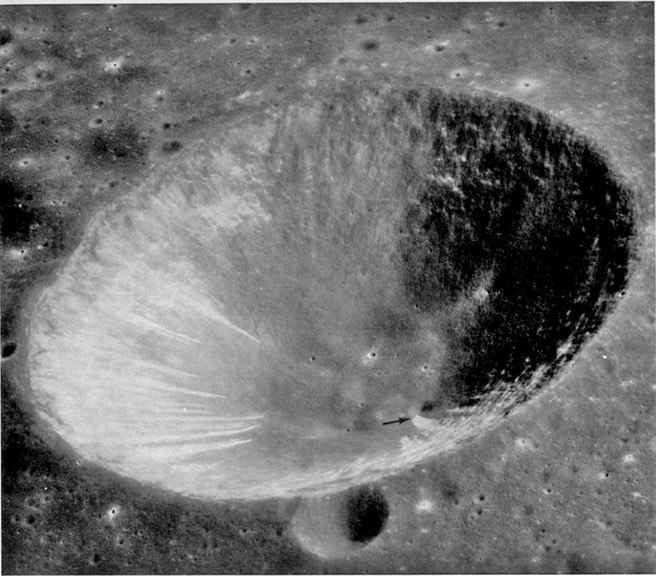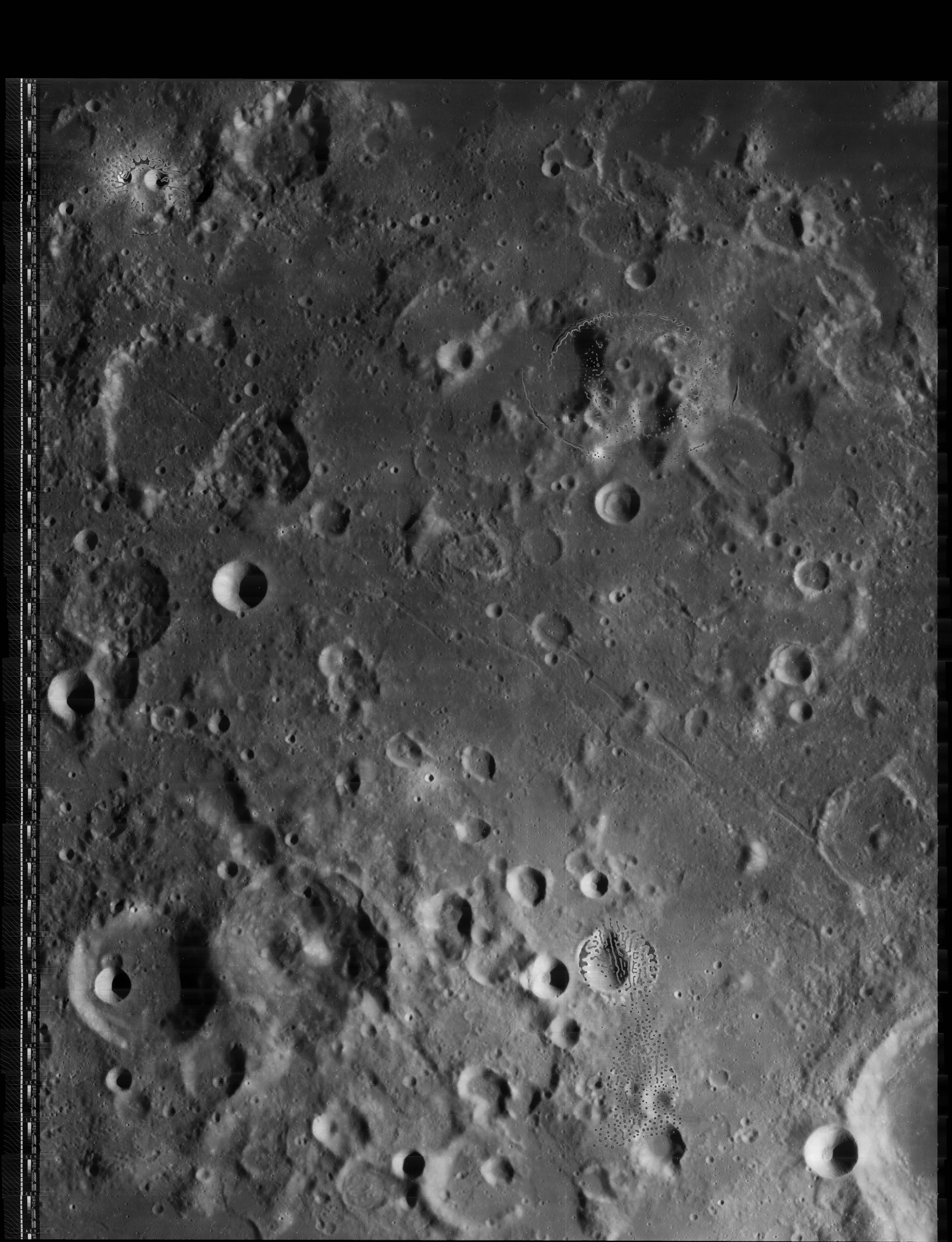LPOD Apr 13, 2008
STREAMERS

Apollo 16 image is Figure 125 in APOLLO OVER THE MOON; A VIEW FROM ORBIT (NASA SP-362; 1978)
Danny Caes recently pointed out the bright streamers on the inner wall of the 15 km wide crater Isidorus D as shown in the picture above. It is an Apollo 16 panoramic camera view from the wonderful book of exceptional Apollo images: APOLLO OVER THE MOON; A VIEW FROM ORBIT. Farouk El-Baz wrote the caption in the book, noting that the white streaks formed by avalanching or sliding of material downslope. Farouk points out that freshly exposed material is brighter than undisturbed materials. Over the decades since SP-362 was written there have been great increases in the understanding of how materials are darken by the solar wind through the formation of microscopic blebs of iron. The arrow points to a streak that stops abruptly - is the mound at the arrowhead the mass of material that slid down revealing the fresh unweathered surface? One final thing - note how the crater at the front of the image is slightly overlapped by Isidorus D, and yet its rim shows no evidence of disturbance by D's ejecta.
Chuck Wood
Technical Details
AS16-4502 (P). Thanks Danny!
Related Links
Rükl plate 47
COMMENTS
To [/LPOD%20Comments post comments] regarding this LPOD, please click here and enter your text in the space below. You will not see the Edit tab unless you register for the wiki. Please do not edit the LPOD itself!
(1) The dark side of the crater wall appears much steeper than the side showing the streaks. Is this just an illusion, or is the angle of the crater walls not uniform?
--Bill
(2) It's an illusion. I wonder how it would look like if the moon had an atmosphere (blue sky and bluish shadows, instead of black). This illusion is also noticeable on lots of Apollo's LEVA photographs (made on the moon's surface). The shadowed eastern part of Rima Hadley's slope (Apollo 15) looks much steeper than the sunlit western part.
I think it (this illusion) is also the reason why so many space-artists (such as Chesley Bonestell and others) painted those typical "Matterhorn"-like lunar mountains instead of the smooth hill-like "golf-terrain" mountains. On the other hand, lunar mountains with slopes of 45 degrees seem to be an existing fact. I think the system of Copernicus' central peaks has such mountains, as seen on the so-called "Picture of the Century" (the well-known Lunar Orbiter photograph of both Copernicus and Fauth in the foreground).
-Danny C.
(3) I agree with Danny that it is an illusion due to the look direction and shadowing. Tomorrow's LPOD wil include some profiles of mountains showing various slopes.
--Chuck
(4) For me, the illusion is, in part due to the orientation of the image, which makes the floor look offset to the right (and tips the right-hand wall "up"). If rotated 17-18 deg so that the axis of the ellipse is horizontal (and the floor more in the center horizontally), the difference in slopes seems much less strong. But as Danny points out, the absence of visual clues as to the direction of the slope in the shadowed part seems to enhance the sense of steepness.
In this particular case, we have what look like the very carefully drawn contours of LTO-79A4 to consult for the actual slopes. The horizontal distance between contour lines can be easily estimated with a ruler (or even more easily with the freeware [/LTVT LTVT]), and the general accuracy of the height scale can be confirmed from the shadows in LO-IV-072H (the shadows indicate a height difference of 3150 m between points where the LTO gives 3200 m). The slope is simply the arc-tangent of the height difference divided by the horizontal distance. The average horizontal distance from the "4000 m" contour near the floor to the "6500 m" contour near the rim is about 4.4 km, for a slope of ArcTan(2500/4400) = 30°. There are places where the heavy 500 m contours are separated horizontally by as little as 0.5 km and as much as 1.3 km, indicating the map maker thought that local slopes in the wall might vary from about 21 to 45°.
Because the floor is shown offset a little to the west in the LTO, the contours are bunched slightly closer together on that side than on the east. Does this mean the slope is really a little steeper on the west (the sunlit side than in the LPOD photo)? Probably not. The reason is that the contours are drawn on a photo background, and even though efforts may be made to "rectify" its overall geometry, individual details are going to be displaced in accordance with the perspective of the viewing angle. Of the background photos mentioned in the caption to LTO-79A4, Isidorus D appears in AS16-M-2938 and AS16-M-2940. The changing apparent offset of the floor of Isidorus D relative to the rim in these two views is quite apparent. Indeed, these offsets are the basis of the stereo mapping: because the rim is higher, it looks consistently "farther" from the camera when viewed looking down, giving a definite elevation to each point that can be recognized in a pair of photos. I'm not familiar enough with the stereo mapping procedure to know if the contours are drawn through the positions at which the measured points appear on one photo or the other or some compromise between the two, but I would suspect the map-maker has biased the contours in this view to match the slightly skewed perspective of the photographic basemap. In that case, even in the LTO the slight difference (of a degree or two) between the apparent average slope of the east and west walls is probably an artifact due to the particular photo selected for the map (AS16-M-2940?). Directly determining whether the floor or a crater this deep is exactly centered or not would seem to require a quite accurately centered overhead view.
One very minor point I find interesting is that even allowing for the problems of perspective, the landslides don't all seem to descend perfectly radially towards the center of the crater. For example, the upper long bright streak on the left (also visible in LO-IV-072H), and the main (but much fainter) streak in the top wall seem to point towards a point quite far from the center of the floor (marked by a pair of tiny craters in the northwest). The wall apparently has enough structure to it that the local direction of fall is not quite what one would expect for a perfect cone. Some of this local structure may be evident in the north wall, which seems to have a pattern of faint corrugations even more skewed (to the left as they go down) than the bright streak.
Regarding the lack of ejecta crossing the 2.3-km crater in the foreground, is it entirely obvious that this crater predates Isidorus D, or might it have impacted after the sharp rim of the latter was already established?
-- Jim Mosher
5) This Apollo photo is interesting from another standpoint. You can see the obvious elevation of the crater rim. Would it be about 1,200 feet above the surrounding surface? This photo looks like it could be used as a good example of a simple, bowl-shaped crater.
--Bill
6) Bill-
From the LTO map that Jim mentioned you can see that the rim is about 700 m above the surrounding terrain, or about 2300 ft. That seems somewhat high, but unless I misread the contours, is right.
Jim -
The softer rim and the interrupted rim are evidence that the small crater was formed before D.
--Chuck
(7) Regarding the small crater in the foreground, it sits on the flank of the raised rim and ejecta of Isidorus D, so to me it seems almost obvious that it post-dates the larger crater otherwise it would be inundated by the larger craters formation. I also see a nearly symetrical discoloration in the upper wall of Isidorus D where that smaller crater must have deformed the subsurface material. Perhaps the landslides in Isidorus D have slowly widened that crater and eroded into that smaller crater, slowly eating it away and revealing the subsurface material? Looking at the original image in Apollo Over the Moon does not really clarify things too much more. There are some marks in the small crater that might indicate ejecta flow from Isidorus D, but I'm not convinced. A look at a Lunar Orbit IV frame doesn't help much, but does show the crater from nearly vertical and a little lower sun angle:

I could imagine that an impact like the one that made the smaller crater might cause just enough local moonquakes that it might trigger landslides in the larger crater in the hours after the main event that might then erode into that smaller crater.
Next, I guess is to run upstairs and look at a print of the original Apollo 16 frame to see if that reveals anything else. BTW, the small crater that cuts the rim in the upper left I could almost be convinced sits above a little enhanced landslide feature, though that might just be my mind playing tricks on me.....
-- Jim Scotti
(8) Jim - Thanks for looking closely at it! Isidorus D landslides might have widen its rim, appearing to make the smaller crater an earlier one.
The upper left crater does seemed to have spawned a landslip - I'd think an impact there would!
Chuck
(9) Chuck, I was thinking that such a large impact crater should obliterate any smaller craters that close to the rim, so it seems like it would have to be a later impact. The expansion of the bigger crater could happen quickly via an impact induced event or of course, more slowly by long term erosion.
BTW, I looked at both AS16-4502 which the Apollo Over the Moon image is extracted from as well as its companion stereo frame of AS16-4507. The resolution was a little better, but not really conclusive in any way. Putting those pan camera frames together in stereo doesn't work very well since there is so much distortion. Isidorus D is fairly close to the northern edge of the pan camera strips and even the perspective induced elongated shapes are oriented quite differently in the 2 frames.
-- Jim Scotti
You can support LPOD when you buy any book from Amazon th'ru LPOD!